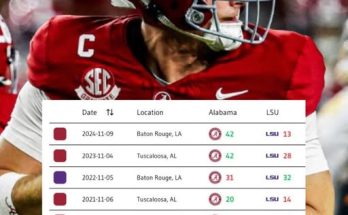Quinn Ewers’ Secret Contribution to Texas Football’s Victory Over Clemson
The Texas Longhorns’ thrilling victory over the Clemson Tigers in the 2025 College Football Playoff (CFP) semifinal was nothing short of a classic. Texas, a team brimming with potential, overcame Clemson’s formidable defense and a well-rounded offense with an awe-inspiring performance. While many fans focused on the standout moments from star players, such as the sensational runs by running back Bijan Robinson and crucial catches by wide receiver Xavier Worthy, it was the quiet, yet undeniable, contribution of quarterback Quinn Ewers that made all the difference in the Longhorns’ win. Ewers’ impact went beyond the stat sheet and overshadowed the spotlight moments. His leadership, poise under pressure, and ability to read the game played a pivotal role in Texas’ triumph.
Quinn Ewers, who had emerged as one of the most promising quarterbacks in the country, has been instrumental to the Longhorns’ rise this season. The young QB brought both talent and maturity to the position, but his contributions in the victory over Clemson were particularly impressive. What seemed like a game of individual highlights was actually the result of a series of decisions, adjustments, and decisions made by Ewers that helped the Longhorns secure the win. His performance served as a blueprint for success, teaching future quarterbacks how to control the tempo of a game, take advantage of opportunities, and inspire his team.
A Steady Hand in a Chaotic Environment
The victory over Clemson was never a guarantee. The Tigers, under head coach Dabo Swinney, had a well-oiled program built around discipline, precision, and execution. The Tigers’ defense, led by defensive coordinator Wes Goodwin, came into the game as one of the top-ranked in the country, and their offense, though not as flashy, was steady enough to capitalize on any mistake made by their opponents. From the first quarter, it was clear that this would not be a straightforward contest. Texas faced relentless pressure from Clemson’s pass rushers, but the Longhorns, with Ewers at the helm, never faltered.
Ewers’ performance throughout the game was emblematic of a quarterback with the poise and maturity of a seasoned veteran. Despite Clemson’s aggressive defensive front, he remained calm in the pocket, reading defenses with an uncanny precision. His quick release, which had been a hallmark of his game all season, was on full display. He also did an excellent job of maintaining his composure even when Clemson brought heavy pressure, showing resilience and the ability to recover after taking a hit. Ewers understood that the game could not be won with one or two explosive plays but required a steady hand to control the tempo and make the necessary adjustments throughout.
It wasn’t just his arm strength or accuracy that made the difference—it was his ability to manage the game. Throughout the contest, Ewers took what Clemson’s defense gave him, making conservative throws to keep the chains moving. He never forced the ball into tight windows, instead opting for the safer passes when necessary. In critical moments, he remained confident and didn’t hesitate to make aggressive throws when he saw the opportunity, but never in a way that would put the Longhorns in jeopardy. It was this measured approach, coupled with a deep understanding of the game, that allowed Texas to stay competitive even when things looked tight.
Reading the Clemson Defense
What truly set Ewers apart in the semifinal was his ability to read and adapt to Clemson’s defensive schemes. Clemson, known for its ability to disguise coverage and create confusion for opposing quarterbacks, presented a constant challenge for Texas’ offensive line and Ewers himself. But Ewers showed off his exceptional football IQ, recognizing key defensive shifts and knowing when to take advantage of them.
In the first half, Clemson’s defense used a mix of man-to-man and zone coverage, often bringing extra pressure to try and rattle Ewers. Early in the game, Ewers seemed to struggle a bit with the intensity of the pressure, but by the second quarter, he had settled into a rhythm. He began making quicker decisions, effectively using his eyes to manipulate defenders and create open lanes for his receivers. He also displayed an advanced understanding of how to read safeties and cornerbacks, often looking them off before making a decision on where to throw the ball.
One of the most notable plays of the game came when Ewers read a blitz from the Clemson linebackers in the second quarter. As the pocket collapsed around him, he quickly recognized the mismatch and fired a quick pass to Bijan Robinson, who was able to make a move and gain 20 yards on the play. This was just one example of how Ewers’ recognition of defensive pressure allowed him to adjust the play on the fly, turning what could have been a sack into a big gain for Texas.
But Ewers’ ability to adapt didn’t just extend to the offensive line or his receivers—it was evident in his running game as well. Throughout the game, Clemson focused heavily on stopping Robinson, making it challenging for the running back to break free. But Ewers’ ability to keep the defense honest by taking off on designed runs or improvising when the pocket collapsed added another layer of complexity to the offense. Ewers wasn’t just a passer; he was a dual-threat that kept Clemson’s defense guessing at every turn.
Creating Opportunities for Others
While Ewers’ individual performance was crucial, it was his ability to elevate those around him that truly stood out. As much as football is a game of individual talent, it’s also a team game, and Ewers showcased that he was more than just a quarterback—he was a leader who made those around him better.
One of the best examples of this came in the second half, when the Longhorns were up by a slim margin. Clemson had just scored a touchdown, and momentum appeared to be shifting in their favor. Texas’ offense needed a spark, and Ewers was the one who provided it. On a critical third-and-10 play, Ewers stood tall in the pocket under immense pressure and delivered a perfectly placed deep ball to Xavier Worthy down the sideline for a 30-yard gain. The throw was in a tight window, but Ewers had the trust and faith in his receiver to deliver it with precision. Worthy, a player who had been quiet for much of the game, was able to make a critical catch and set up the Longhorns for another touchdown.
The chemistry between Ewers and his receivers was evident all game long. Even when things weren’t going perfectly, Ewers’ confidence never wavered, and that confidence was contagious. Worthy, Robinson, and tight end Ja’Tavion Sanders all stepped up when their number was called, and Ewers was able to deliver the ball to them in positions that allowed them to succeed. This ability to make everyone around him better was one of the key reasons the Longhorns were able to continue to move the ball and score crucial points against Clemson.
The Critical Third Quarter Adjustments
Football games often pivot on key adjustments made at halftime. Texas’ coaching staff, led by head coach Steve Sarkisian, was able to make adjustments that were crucial to the second-half success. But it was Ewers’ ability to execute those adjustments that made them effective. The Longhorns came out of the break with a renewed sense of urgency, and Ewers was at the forefront of that.
Clemson had made a noticeable shift in the second quarter, playing more zone defense and dropping more players into coverage in an attempt to slow down Texas’ high-octane offense. Ewers, however, was ready for the change. In the third quarter, he effectively took what the defense gave him—he threw a series of quick slant passes and outs to his receivers, which not only gained yards but also kept the Clemson defense off balance. This move forced Clemson’s secondary to play tighter, which opened up running lanes for Robinson and forced the linebackers to drop back in coverage. By making these small adjustments, Ewers was able to stretch the defense horizontally and create bigger opportunities for his teammates.
One particular moment stands out when Ewers noticed Clemson’s defense was playing more conservatively, trying to prevent the deep ball. He adjusted his throws to focus more on the intermediate routes, finding tight end Ja’Tavion Sanders over the middle. Sanders made a key catch on third down that kept a crucial drive alive, and the Longhorns ended up scoring another touchdown.
Leadership Beyond the Stats
At the end of the day, Quinn Ewers’ biggest contribution to Texas’ victory wasn’t just in the numbers he put up on the stat sheet, but in his leadership and command of the offense. In a game that had the intensity of a playoff showdown, Ewers demonstrated the poise, maturity, and awareness of a quarterback far beyond his years. He never panicked in the face of adversity, and he consistently made the right decisions when the game was on the line.
As Texas continued to grind out its lead, Ewers’ ability to calm the nerves of his teammates was evident. His confidence in crucial moments, such as when the game was tied late in the fourth quarter, was the backbone of Texas’ final push. When the Longhorns needed a first down to ice the game, Ewers delivered yet another clutch throw to Worthy, helping Texas seal the victory.
Ultimately, Quinn Ewers’ contribution to the Longhorns’ victory over Clemson was far more than just a string of impressive throws. It was his ability to manage the game, read defenses, elevate his teammates, and lead his team through a challenging contest. The victory may have been a team effort, but without Ewers’ intelligence, poise, and leadership, it’s likely that Texas would not have been able to weather the storm against a talented Clemson squad.
As the Longhorns prepare for their next challenge, they can rest assured knowing that they have a quarterback who not only possesses the physical tools to succeed but also the mental toughness and leadership to carry them through the toughest of games.



